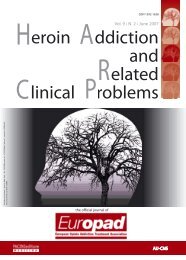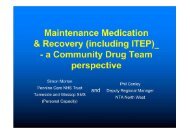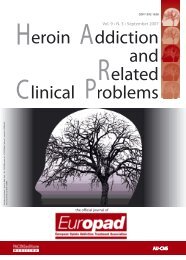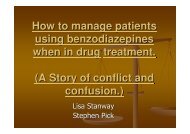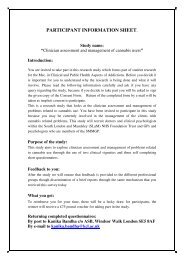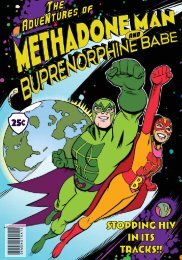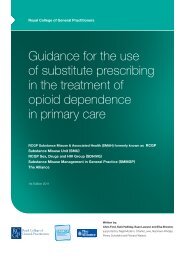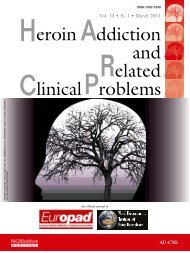cocaine guidance - Royal College of General Practitioners
cocaine guidance - Royal College of General Practitioners
cocaine guidance - Royal College of General Practitioners
- No tags were found...
You also want an ePaper? Increase the reach of your titles
YUMPU automatically turns print PDFs into web optimized ePapers that Google loves.
viGuidance for working with <strong>cocaine</strong> and crack users in primary careExecutive summaryDifferent types <strong>of</strong> user communitiesBlack and minority ethnic groups■ Crack use is <strong>of</strong>ten heavily associated in the mediawith black people as the stereotype <strong>of</strong> crack users issteeped in historical racism. In reality many differentpeople from all communities use <strong>cocaine</strong>/crack.However concerns about the spread <strong>of</strong> crack use andits impact on communities have been expressed bymany African Caribbeans. There are also concernsabout the patchy coverage <strong>of</strong> services that can meetthe needs <strong>of</strong> these users.■ The basics <strong>of</strong> treatment in primary care are the samefor any patient, but those primary care services treatingusers from different cultural backgrounds need to beaware <strong>of</strong> this issue and how it may impact upon theuser, staff and the service itself.■ Specific black and minority ethnic groups healthissues such as sickle cell anaemia can also beexacerbated by the use <strong>of</strong> crack and <strong>cocaine</strong>.Young people (under 18 years old)■ When a young person presents, it is important toaddress the individual and not solely the drug(s).Confidentiality and respect is essential.■ If the young person is under 16 years, they shouldbe referred to a specialist young person’s service.If they are unlikely to attend, then it is reasonable touse the Fraser Guidelines.■ When seeing a young person alone, take a history,assess and discuss harm reduction in the same wayas with other patients. Provide appropriate writtenadvice and be aware that young people may uselanguage that you don’t understand, so ask themto explain what they mean.Women, pregnancy and child protection issuesWomen■ Crack use can disrupt the menstrual cycle mainlythrough poor general health and chaotic lifestyle.■ Offer contraception.■ Many women may also have drug-using partners whoneed treatment and it is always better to providehelp and treatment to both at the same time.■ Primary care is well placed to provide <strong>guidance</strong> towomen on safer drug use and good sexual health.Use in pregnancyPregnant women need good information about crackand its effects to allow them to make choices.Confidentiality is essential and outcomes improve withconsistent advice, support, reassurance, integratedcare services and consistency <strong>of</strong> attendance.There is some evidence that suggests there is a linkbetween stillbirths, miscarriages through placentaldetachment (placenta abruptio), premature labour anddelivery and low birth weight and small-for-dates babies,though this may reflect lifestyle and smoking rather thana direct effect. Placental abruptio and pre-term rupture<strong>of</strong> membranes are the only confirmed problems associatedwith <strong>cocaine</strong> use.Approximately one quarter to one third <strong>of</strong> the <strong>cocaine</strong>will pass across the placental barrier to the foetus, whichmay lead to agitation and apnoea initially at birth. Most<strong>of</strong> these symptoms will settle by comforting the babyand avoiding loud noises or bright lights. The ‘crack’baby image is a myth.Heavy <strong>cocaine</strong> use is likely to be incompatible withsuccessful breast-feeding. If breast-feeding is to besuccessful, then <strong>cocaine</strong> use should be kept to a minimum.With the exception <strong>of</strong> HIV positive women, all mothersshould be encouraged to breast-feed.There is some evidence <strong>of</strong> later developmentalproblems, but research is conflicting.



